Explanatory Memorandum
(Circulated by authority of the Treasurer, the Hon Peter Costello, MP)Chapter 6 - Transfer of losses within wholly-owned groups of companies
Outline of Chapter
6.1 Schedule 5 to this Bill inserts new Subdivision 170-C into the ITAA 1997. Subdivision 170-C will prevent the duplication of a tax loss which has been transferred between wholly-owned group companies, where direct or indirect interests in the loss company are realised.
6.2 Where a tax loss is transferred:
- •
- cost base and reduced cost base reductions will be required to be made in certain circumstances to equity interests acquired on or after 20September 1985 (post-CGT) and held directly or indirectly in the loss company;
- •
- reduced cost base reductions will be required to be made in certain circumstances to debt interests acquired post-CGT and held directly or indirectly in the loss company; and
- •
- in some cases, cost base and reduced cost base increases to post-CGT interests held directly or indirectly in the income company will also be necessary.
6.3 New Subdivision 170-C will also contain provisions replacing the current cost base and reduced cost base adjustment regime where a net capital loss is transferred between companies in a wholly-owned group. The policy approach underlying the current law has been maintained.
Context of Reform
6.4 Loss duplication arises when a single economic loss is recognised by the taxation system more than once. This can occur because losses realised in an entity are reflected in the value of interests in that entity.
6.5 A form of loss duplication, called loss cascading , occurs where losses are artificially duplicated through a chain of companies. This is facilitated by the existence of loss transfer and asset roll-over concessions applying to wholly-owned company groups. Some forms of loss cascading are prevented under the existing law but others are not.
6.6 An example of where loss cascading is not prevented is where a group company, which has incurred a revenue loss (referred to as a tax loss) for a year of income, transfers the loss to another group company under Subdivision 170-A of the ITAA 1997. Subdivision 170-A allows the transfer of tax losses between companies in the same wholly-owned group. Broadly, the amount of loss that can be transferred under Subdivision 170-A is equal to the amount that can be used by the company receiving the loss in that year of income.
6.7 If the tax loss (transferred under Subdivision 170-A) also reduced the value of direct and indirect interests (e.g. shares) held in the loss company, the tax loss can be duplicated by the sale (or other realisation) of the direct or indirect interests held in the loss company. (Where the loss is wholly attributable to a tax incentive, duplication cannot occur).
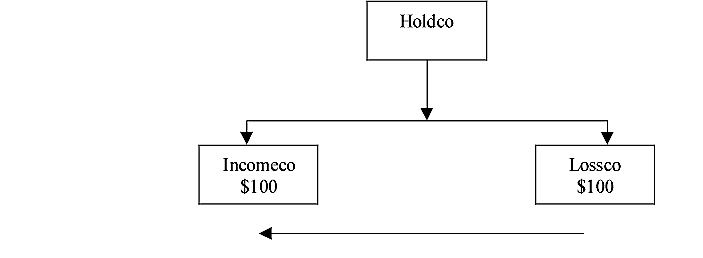
Holdco capitalises Incomeco and Lossco each with $100 post-CGT. Lossco subsequently makes a tax loss of $50. Lossco transfers the loss to Incomeco. Incomeco gives no consideration for the transfer of the tax loss. The loss that Lossco makes reduces the value of the shares held by Holdco in Lossco by $50.
If Holdco subsequently disposes of the shares in Lossco (CGT event A1) for $50, it would make a loss of $50 (being the difference between the $100 reduced cost base of the shares and $50). This loss is a duplicate of the $50 loss transferred to Incomeco.
6.8 Subdivision 170-B of the ITAA 1997 deals with the transfer of net capital losses within wholly-owned groups of companies. Broadly, the conditions for the transfer of a loss under Subdivision 170-B mirror those in Subdivision 170-A.
6.9 However, Subdivision 170-B prevents loss duplication where a net capital loss is transferred by requiring cost base and reduced cost base reductions to interests held directly or indirectly in the loss company. Section 170-175 of Subdivision 170-B requires appropriate reductions to the cost base and reduced cost base of direct and indirect share and debt interests in a loss company following the transfer of a net capital loss. Section 170-180 of Subdivision 170-B allows for increases to the cost base and reduced cost base of direct and indirect share and debt interests in the gain company to reflect any increase in their market value because of the transfer of the net capital loss.
Using the facts in Example 6.1, if the loss transferred were a net capital loss, section 170-175 would require a reduction to the cost base and reduced cost base of the shares in Lossco of $50, being the amount of the loss transferred. In addition, section 170-180 would allow an increase to the cost base and reduced cost base of the shares in Incomeco of $18 ($50 * 36%), being the tax benefit of the amount of the loss transferred (in the absence of any consideration given by Incomeco for the transfer).
6.10 Subdivision 170-A does not contain provisions to prevent the duplication of a tax loss transferred. This Bill will remedy this by introducing a new Subdivision 170-C, which will require cost base and reduced cost base adjustments where a tax loss is transferred between companies in a wholly-owned group. New Subdivision 170-C will also replace the provisions in Subdivision 170-B that require cost base and reduced cost base adjustments where a net capital loss is transferred between companies in a wholly-owned group.
6.11 The cost base adjustment mechanisms contained in new Subdivision 170-C will be based on those currently contained in Subdivision 170-B. However, the new provisions will clarify the circumstances in which an adjustment should be made, the amount of the adjustment required and when the adjustment is to be made.
Summary of new law
6.12 New Subdivision 170-C will apply where a tax loss or net capital loss is transferred between companies in the same wholly-owned group. Where a loss is transferred:
- •
- cost base and reduced cost base reductions will be required to be made in certain circumstances to post-CGT equity interests held directly or indirectly in the loss company;
- •
- reduced cost base reductions will be required to be made in certain circumstances to post-CGT debt interests held directly or indirectly in the loss company; and
- •
- in some cases, cost base and reduced cost base increases to post-CGT interests held directly or indirectly in the income company or the gain company will also be necessary.
6. 13 New Subdivision 170-C specifies factors to be taken into account in determining whether a cost base and reduced cost base adjustment should be made and, if so, the appropriate amount. Subdivision 170-C also specifies when the adjustments are to be made.
Detailed explanation of new law
6.14 Item 12 of Schedule 5 to this Bill inserts new Subdivision 170-C into the ITAA 1997. New Subdivision 170-C prescribes cost base and reduced cost base adjustments for direct and indirect equity interests, and reduced cost base adjustments for direct and indirect debt interests, in companies in a wholly-owned group where a net capital loss or tax loss is transferred between them. [Section 170-201]
6.15 The main object of new Subdivision 170-C is to prevent the duplication of tax losses or net capital losses which are transferred between companies in the same wholly-owned group [section 170-205] . As mentioned at paragraph 6.4, this can occur because losses realised by an entity are reflected in the values of interests in that entity. Duplication can occur if a CGT event happens in relation to equity or debt interests held directly or indirectly in the loss company. Duplication can take the form of the making of a loss or the reduction of a capital gain that would otherwise have been made. However, duplication only occurs if the group obtains the benefit of an economic loss more than once.
6.16 The effect of new section 170-205 (and the relevant factors specified in this Bill) is that where there is no duplication of a transferred loss (e.g. because the loss transferred is wholly attributable to a tax incentive), then no reductions will be required under new Subdivision 170-C. This is the case whether the tax incentive creates a permanent difference or a timing difference for the purposes of tax effect accounting.
6.17 New Subdivision 170-C also provides for adjustments to increase the cost base and reduced cost base of equity and debt interests held directly or indirectly by a group company in the income or gain company. The adjustment reflects the increase in the market value of the interest because of the transfer of the loss. However, the adjustment is only made if the increase is still reflected in the market value of the interest when a CGT event happens in relation to it. [Section 170-205]
6.18 As mentioned at paragraph 6.10, new Subdivision 170-C deals with the transfer of both tax losses and net capital losses. The cost base and reduced cost base adjustment mechanisms are identical for both types of loss transfers.
Direct interests in the loss company
6. 19 Reductions to the cost base and reduced cost base of a direct equity interest, and to the reduced cost base of a direct debt interest, in a loss company, where a tax loss is transferred, will be required where the following conditions are met:
- •
- an amount of a tax loss is transferred by a company to another company;
- •
- Subdivision 170-A applies to the transfer;
- •
- a company (the group company ) holds a share in the loss company or is owed a debt by the loss company in respect of a loan;
- •
- the group company acquired the share or debt post-CGT; and
- •
- throughout the deduction year, the group company is a member of the same wholly-owned group as the loss company (disregarding a period when either was not in existence).
6. 20 The reference to an amount of a tax loss or an amount of a net capital loss in new Subdivision 170-C ensures that where a company incurs a tax loss or net capital loss but is only able to transfer part of that loss under Subdivision 170-A or Subdivision 170-B, then new Subdivision 170-C will still apply to the transfer of that part of the tax loss or net capital loss.
Indirect interests in the loss company
6. 21 Reductions to the cost base and cost base of an indirect equity interest, and to the reduced cost base of an indirect debt interest, in a loss company, where a tax loss is transferred, will be required where the following conditions are met:
- •
- an amount of a tax loss is transferred by a company to another company;
- •
- Subdivision 170-A applies to the transfer;
- •
- a company (the group company ) holds a share in another company or is owed a debt by another company in respect of a loan;
- •
- the group company acquired the share or debt post-CGT;
- •
- the money that the group company paid for the share, or the borrowed money, has been applied (directly, or indirectly through one or more interposed entities):
- -
- in the other company or a third company acquiring shares in the loss company; or
- -
- in a borrowing by the loss company from the other company or from a third company; and
- •
- throughout the deduction year, the group company, the other company and the third company (if any) are all members of the same wholly-owned group as the loss company (disregarding, for a particular company, a period when it was not in existence).
6.22 The amount of the reduction to the cost base and reduced cost base of a share, or the reduced cost base of a debt, for the purposes of new subsections 170-210(1) and 170-210(2), is determined under new subsection 170-210(3).
6.23 The reduction will be an amount that is appropriate having regard to the following factors:
- •
- the group companys direct or indirect interest in the loss company;
- •
- the amount of the loss transferred (which is the maximum reduction to any interest);
- •
- the extent to which the loss reduced the market value of the share or debt;
- •
- any consideration received by the loss company for the loss transferred; and
- •
- whether, because of a dividend or dividends paid by the loss company, the consideration is no longer reflected wholly or partly in the market value of the share or debt when a CGT event happens in relation to it.
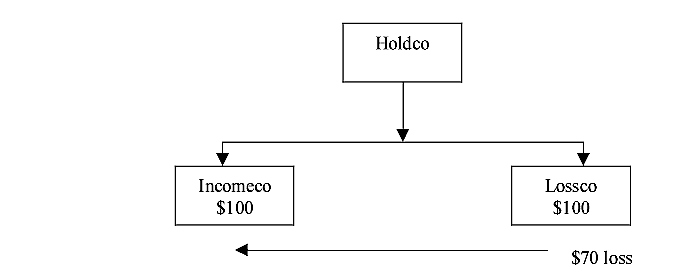
Holdco capitalises Incomeco and Lossco each with $100 post-CGT. Lossco subsequently makes a tax loss of $70. Lossco transfers the loss to Incomeco. No consideration is given by Incomeco for the transfer. The loss that Lossco makes reduces the value of the shares held by Holdco in Lossco by $70. Holdco subsequently disposes of the shares in Lossco for $30 (CGT event A1) .
The reduction in the cost base and reduced cost base of the shares in Lossco under new subsection 170-210(1) would be equal to $70, being the amount of the loss transferred in this case. Therefore, Holdco would make no capital gain or capital loss on the disposal of the shares in Lossco as the cost base and reduced cost base of the shares in Lossco would be reduced to $30.
If the reduction to the cost base and reduced cost base of the shares in Lossco were less than $70, Holdco would make a capital loss on the disposal of the shares in Lossco. This loss would duplicate (partly or wholly) the amount of the loss transferred by Lossco to Incomeco.

Holdco capitalises Incomeco and Lossco each with $100, $50 pre-CGT and $50 post-CGT. All shares are of the same class. Lossco subsequently makes a tax loss of $50. Lossco transfers the loss to Incomeco for no consideration. The loss that Lossco makes reduces the value of all the shares held by Holdco in Lossco by $50. Holdco subsequently disposes of the shares in Lossco for $50 (CGT eventA1).
The reduction in the cost base and reduced cost base of the post-CGT shares in Lossco under new subsection 170-210(1) would in this case be equal to $25, being the extent to which the loss transferred reduced the market value of the post-CGT shares.
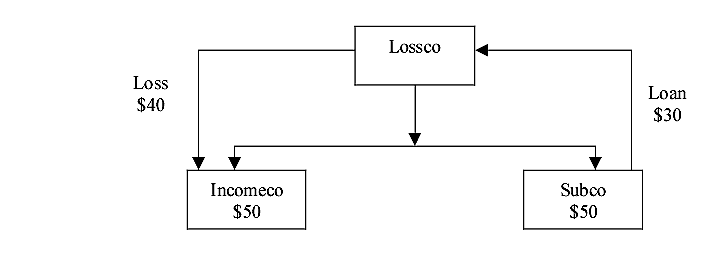
Lossco capitalises Incomeco and Subco with $50 each post-CGT. Subco also makes a loan of $30 to Lossco. Lossco subsequently makes a tax loss of $40. Lossco transfers the loss to Incomeco for no consideration.
Whether new section 170-210 will require reductions to the reduced cost base of the loan from Subco to Lossco will depend on whether the market value of the loan is affected by the loss. If its market value were not affected, then no reduction would be required. However, if the market value were affected, it would be appropriate to make reductions to prevent the duplication of the transferred loss.
6.24 In determining the extent to which the loss reduces the market value of the share or debt, the tax benefit associated with the loss is to be disregarded. Regard should only be had to how the loss impacts on the value of the share or debt when the loss is suffered.
6.25 As discussed at paragraph 6.16, it would not be appropriate to reduce the cost base and reduced cost base of equity interests, or the reduced cost base of debt interests, in a loss company where the loss transferred is not an economic loss (e.g. the loss is wholly attributable to a tax incentive ). This is because the object of new Subdivision 170-C is to prevent a group company duplicating a loss transferred.
6.26 New subsection 170-210(3) requires any consideration received by the loss company for the transfer of the loss to be taken into account in determining the amount of any adjustment. Consideration paid for the transfer of a tax or net capital loss is called a subvention payment. A subvention payment cannot exceed the commercial value of the loss. This is because only the amount of the payment up to the commercial value of the loss can be said to be consideration received by the loss company for the loss transferred . The commercial value of a loss is, at most, equal to the tax benefit of the loss (i.e. the amount of the loss multiplied by the applicable company tax rate) which is the amount of tax saved by the income company because of the transfer.
6.27 Example 6.6 illustrates how a subvention payment is taken into account in determining reductions under new subsection 170-210(3).
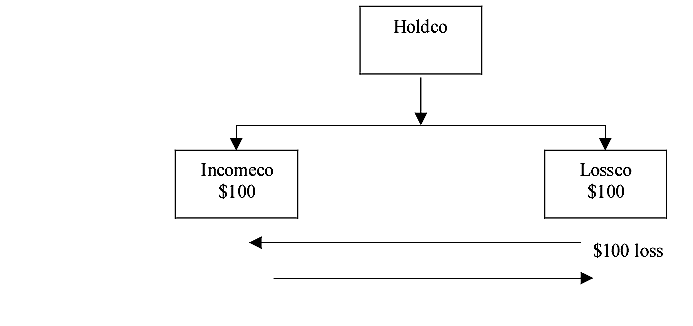
Holdco capitalises Incomeco and Lossco each with $100 post-CGT. Lossco subsequently makes a tax loss of $100. Lossco transfers the loss to Incomeco in return for a subvention payment of $36. The loss that Lossco makes reduces the value of the shares held by Holdco in Lossco by $100. Holdco subsequently sells the shares in Lossco for their market value of $36.
The cost base and reduced cost base of the shares in Lossco would be reduced under new subsection 170-210(1) by $64 (so that it would now be $36), being the amount of loss of $100 less the subvention payment of $36. Therefore, Holdco would make no gain or loss on the disposal of the shares in Lossco.
If no cost base or reduced cost base reduction were made, a capital loss of $64 would be made on the sale of Holdcos shares in Lossco. That loss would duplicate $64 of the $100 tax loss transferred and utilised within the group. A cost base and reduced cost base reduction of $64 is appropriate even though a subvention payment has been made equal to the tax benefit of the loss transferred.
6.28 Consideration paid for a tax loss is not taken into account in determining reductions under new subsection 170-210(3) if, because of a dividend or dividends paid by the loss company, the consideration is no longer reflected wholly or partly in the market value of the share or debt when a CGT event happens in relation to it.
6.29 Consideration paid for a loss will be taken to be reflected wholly or partly in the market value of the share or debt at the time of the CGT event if it can be demonstrated that a dividend has not subsequently been paid by the loss company or if there is an amount of undistributed accounting profit in the loss companys accounts equal to the amount of the consideration. In the second case, there is no requirement to demonstrate that the profit represents the actual consideration, as long as the amount of consideration is present. If only part of the amount of consideration is present in the accounts, then only that part will be able to be taken into account in determining the adjustment to the cost base and reduced cost base of the share or debt.
Using the facts from Example 6.6, the reduction in the cost base and reduced cost base of the shares in Lossco calculated under new subsection 170-210(3) would be equal to $64 (and not $100) only if Lossco had not paid a dividend to Holdco after the loss transfer or if Lossco had at least $36 undistributed accounting profits (from any source) recorded in its accounts. If Lossco had only $10 undistributed profits, a reduction of $90 would be required.
6.30 Any reduction is to be made immediately before a CGT event happens in relation to the share or debt and is to have effect from that time or the end of the year of income in which the loss was transferred (i.e. the deduction year), whichever is the earlier [subsection 170-210(4)] . The reduction will generally have effect from the end of the deduction year. This will ensure that indexation will only be available on the cost base of the share as reduced under new subsection 170-210(1) or 170-210(2). However, the reduction is made immediately before the CGT event so that regard can be had to whether any consideration paid for the loss is still reflected (wholly or partly) in the market value of the share or debt at that time.
6.31 New subsection 170-210(4) will also ensure that where a company is dissolved during the year of transfer, any reduction is made at, and will have effect from immediately before, the time of the dissolution.
Direct interests in the income company
6.32 Increases to the cost base and reduced cost base of a direct interest (share or debt) in an income company, to which a tax loss is transferred, will be required where the following conditions are met:
- •
- an amount of a tax loss is transferred by a company to another company;
- •
- Subdivision 170-A applies to the transfer;
- •
- a company (the group company ) holds a share in the income company or is owed a debt by the income company in respect of a loan;
- •
- the group company acquired the share or debt post-CGT; and
- •
- throughout the deduction year, the group company is a member of the same wholly-owned group as the income company (disregarding a period when either was not in existence).
Indirect interests in the income company
6. 33 Increases to the cost base and reduced cost base of an indirect interest in an income company, to which a tax loss is transferred, will be required where the following conditions are met:
- •
- an amount of a tax loss is transferred by a company to another company;
- •
- Subdivision 170-A applies to the transfer;
- •
- a company (the group company ) holds a share in another company or is owed a debt by another company in respect of a loan;
- •
- the group company acquired the share or debt post-CGT;
- •
- the money that the group company paid for the share, or the borrowed money, has been applied (directly, or indirectly through one or more interposed entities):
- -
- in the other company or a third company acquiring shares in the income company; or
- -
- in a borrowing by the income company from the other company or from a third company; and
- •
- throughout the deduction year, the group company, the other company and the third company (if any) are all members of the same wholly-owned group as the income company (disregarding, for a particular company, a period when it was not in existence).
6.34 The amount of the increase to the cost base and reduced cost base of a share or debt, for the purposes of new subsections 170-215(1) and 170-215(2), is determined under new subsection 170-215(3).
6.35 The increase will be an amount that is appropriate having regard to the following factors:
- •
- the group companys direct or indirect interest in the income company;
- •
- the amount of the loss transferred; and
- •
- any consideration given by the income company for the loss transferred.
6.36 However, the increase cannot exceed the increase in the market value of the share or debt that results from the transfer of the loss [subsection 170-215(4)] . For example, if the income company makes a subvention payment for the transfer of the loss and the amount of the payment is equal to the commercial value of the loss transferred, then there would be no increase to the cost base and reduced cost base of the share or debt. Conversely, if no subvention payment were made for the transfer of the loss, then the increase would be limited to the increase in the market value of the share or debt because of the transfer of the loss.
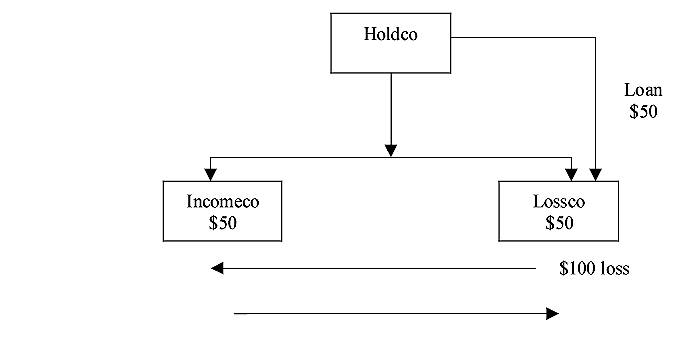
Holdco capitalises Incomeco and Lossco each with $50 post-CGT. Holdco also makes a loan of $50 to Lossco. Lossco then trades profitable for several years. Lossco subsequently makes a tax loss of $100 which it transfers to Incomeco in return for a $36 subvention payment.
Assuming that the market value of the loan was unaffected by the loss, the loss reduced the value of the shares by $100 and the subvention payment increased the value of the shares by $36, the reduction in the cost base and reduced cost base of the shares in Lossco under new subsection 170-210(1) would be equal to a maximum of $50, reducing them to nil.
If on the other hand Lossco had not increased in value before the loss was transferred, the loss reduced the market value of the shares and loan by $50 each, and the subvention payment restored $36 value in the loan, the cost base and reduced cost base of the shares would be reduced by $50 and the reduced cost base of the loan by $14.
There would be no increase in the cost base and reduced cost base of the shares in Incomeco under new subsection 170-215(1) because the amount of consideration for the tax loss is equal to its commercial value ($36). Therefore, the market value of Incomecos shares is not increased by the loss transfer.
6.37 Any increase to the cost base and reduced cost base of a share or debt is to be made immediately before a CGT event happens in relation to the share or debt and is to have effect from that time or the end of the deduction year, whichever is the earlier [subsection 170-215(5)] . The increase will generally have effect from the end of the deduction year. This will ensure that indexation will be available on the cost base of the share or debt as increased under new subsection 170-215(1) or 170-215(2).
6.38 New subsection 170-215(5) will also ensure that where a company is dissolved during the year of transfer, any increase is made at, and will have effect from immediately before, the time of the dissolution.
6.39 No increase is to be made to the cost base and reduced cost base of a share or debt to the extent to which, because of a dividend or dividends paid by the income company, the increase in the market value of the share or debt that resulted from the transfer of the loss is no longer in existence at the time when a CGT event happens in relation to the share or debt. [Subsection 170-215(6)]
6.40 The operation of new subsection 170-215(6) means that any adjustments required under new subsections 170-215(1) and 170-215(2) can only be made at the time immediately before the CGT event (as required by new subsection 170-215(5)). This is so regard can be had to whether the increase in the market value that resulted from the transfer of the loss still exists (wholly or partly) at the time of the CGT event.
6.41 The increase in the market value that resulted from the transfer of the loss will be taken to be still in existence at the time of the CGT event if it can be demonstrated that a dividend has not been paid by the income company since the transfer or if there is an amount of undistributed profits in the income companys accounts at the time of the CGT event equal to the market value increase. If only part of the amount of market value increase is represented, then only that part will be able to be used to increase the cost base and reduced cost base of the share or debt.
Transfer of a net capital loss
6. 42 As mentioned at paragraph 6.10, the cost base and reduced cost base adjustment mechanism for the transfer of net capital losses is identical to the mechanism for the transfer of tax losses. Therefore, the previous discussion of the tax loss transfer provisions in paragraphs 6.19 to 6.41 is of equal relevance to the net capital loss transfer provisions outlined in paragraphs 6.43 to 6.54.
Direct interests in the loss company
6. 43 Where a net capital loss is transferred, reductions will be required to the cost base and reduced cost base of a direct equity interest, or the reduced cost base of a direct debt interest, in a loss company where the following conditions are met:
- •
- an amount of a net capital loss is transferred by a company to another company;
- •
- Subdivision 170-B applies to the transfer;
- •
- a company (the group company ) holds a share in the loss company or is owed a debt by the loss company in respect of a loan;
- •
- the group company acquired the share or debt post-CGT; and
- •
- throughout the year of income in which the loss was transferred (the application year), the group company is a member of the same wholly-owned group as the loss company (disregarding a period when either was not in existence).
Indirect interests in the loss company
6. 44 Where a net capital loss is transferred, reductions will be required to the cost base and reduced cost base of an indirect equity interest, or the reduced cost base of an indirect debt interest, in a loss company where the following conditions are met:
- •
- an amount of a net capital loss is transferred by a company to another company;
- •
- Subdivision 170-B applies to the transfer;
- •
- a company (the group company ) holds a share in another company or is owed a debt by another company in respect of a loan;
- •
- the group company acquired the share or debt post-CGT;
- •
- the money that the group company paid for the share, or the borrowed money, has been applied (directly, or indirectly through one or more interposed entities):
- -
- in the other company or a third company acquiring shares in the loss company; or
- -
- in a borrowing by the loss company from the other company or from a third company; and
- •
- throughout the application year, the group company, the other company and the third company (if any) are all members of the same wholly-owned group as the loss company (disregarding, for a particular company, a period when it was not in existence).
6.45 The amount of the reduction to the cost base and reduced cost base of a share, or the reduced cost base of a debt, for the purposes of new subsections 170-220(1) and 170-220(2) is determined under new subsection 170-220(3).
6.46 The reduction will be an amount that is appropriate having regard to the following factors:
- •
- the group companys direct or indirect interest in the loss company;
- •
- the amount of the loss transferred;
- •
- the extent to which the loss reduced the market value of the share or debt;
- •
- any consideration received by the loss company for the loss transferred; and
- •
- whether, because of a dividend or dividends paid by the loss company, the consideration is no longer reflected wholly or partly in the market value of the share or debt when a CGT event happens to it.
6.47 Any reduction is to be made immediately before a CGT event happens in relation to the share or debt and is to have effect from that time or the end of the application year, whichever is the earlier. [Subsection 170-220(4)]
Direct interests in the gain company
6. 48 Where a net capital loss is transferred, increases will be required to the cost base and reduced cost base of a direct interest (share or debt) in a gain company where the following conditions are met:
- •
- an amount of a net capital loss is transferred by a company to another company;
- •
- Subdivision 170-B applies to the transfer;
- •
- a company (the group company ) holds a share in the gain company or is owed a debt by the gain company in respect of a loan;
- •
- the group company acquired the share or debt post-CGT; and
- •
- throughout the application year, the group company is a member of the same wholly-owned group as the gain company (disregarding a period when either was not in existence).
Indirect interests in the gain company
6. 49 Where a net capital loss is transferred, increases will be required to the cost base and reduced cost base of an indirect interest in a gain company where the following conditions are met:
- •
- an amount of a net capital loss is transferred by a company to another company;
- •
- Subdivision 170-B applies to the transfer;
- •
- a company (the group company ) holds a share in another company or is owed a debt by another company in respect of a loan;
- •
- the group company acquired the share or debt post-CGT;
- •
- the money that the group company paid for the share, or the borrowed money, has been applied (directly, or indirectly through one or more interposed entities):
- -
- in the other company or a third company acquiring shares in the gain company; or
- -
- in a borrowing by the gain company from the other company or from a third company; and
- •
- throughout the application year, the group company, the other company and the third company (if any) are all members of the same wholly-owned group as the gain company (disregarding, for a particular company, a period when it was not in existence).
6.50 The amount of the increase to the cost base and reduced cost base of a share or debt, for the purposes of new subsections 170-225(1) and 170-225(2) is determined under new subsection 170-225(3).
6.51 The increase will be an amount that is appropriate having regard to the following factors:
- •
- the group companys direct or indirect interest in the gain company;
- •
- the amount of the loss transferred; and
- •
- any consideration given by the gain company for the loss transferred.
6.52 However, the increase cannot exceed the increase in the market value of the share or debt that results from the transfer of the loss. [Subsection 170-225(4)]
6.53 Any increase is to be made immediately before a CGT event happens in relation to the share or debt and is to have effect from that time or the end of the application year, whichever is the earlier. [Subsection 170-225(5)]
6.54 No increase is to be made to the cost base and reduced cost base of a share or debt to the extent to which, because of a dividend or dividends paid by the gain company, the increase in the market value of the share or debt that resulted from the transfer of the loss is no longer in existence at the time when a CGT event happens in relation to the share or debt. [Subsection 170-225(6)]
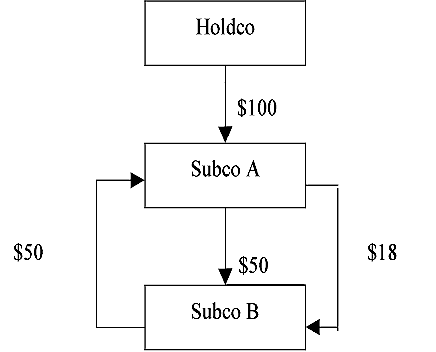
Holdco capitalises Subco A with $100 post-CGT. Subco A then capitalises Subco B with $50. Subco B subsequently makes a net capital loss (tax loss) of $50. Subco B transfers the loss to Subco A in return for a subvention payment of $18. The loss that Subco B made reduces the value of the shares held by Subco A in Subco B by $50.
The cost base and reduced cost base of the shares held by Subco A in Subco B would be reduced by $32. This is calculated as the amount of the loss transferred ($50) less the amount of the subvention payment ($18). This would prevent the loss of $50 being duplicated on the sale of the shares in Subco B.
On the facts above, it would not be appropriate to make an adjustment to the cost base and reduced cost base of the shares held by Holdco in Subco A. This is because there would be no duplication of the $50 transferred loss if the shares in Subco A were sold. In addition, the commercial value of the loss transferred to Subco A is equal to the subvention payment made for the loss.
If prior to Holdco selling Subco A, the capital gain (assessable income) sheltered by the transferred loss is paid as a dividend to Holdco (net of the subvention payment), it would be appropriate to reduce the cost base and reduced cost base of the shares held by Holdco in Subco A by $32. This is to prevent a $32 capital loss being realised on the sale of the shares in Subco A, which would duplicate part of the $50 transferred loss.
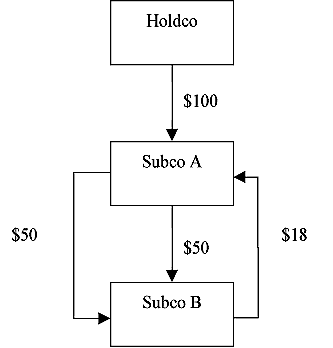
Holdco capitalises Subco A with $100 post-CGT. Subco A then capitalises Subco B with $50. Subco A subsequently makes a net capital loss (tax loss) of $50. Subco A transfers the loss to Subco B in return for a subvention payment of $18. Holdco immediately sells Subco A.
On the facts above, it would not be appropriate to make an adjustment to the cost base and reduced cost base of the shares held by Holdco in Subco A. This is because there would be no duplication of the $50 transferred loss if the shares in Subco A were sold.
There would be no adjustment to the cost base and reduced cost base of the shares held by Subco A in Subco B. This is because the commercial value of the loss transferred is equal to the subvention payment made for the loss.
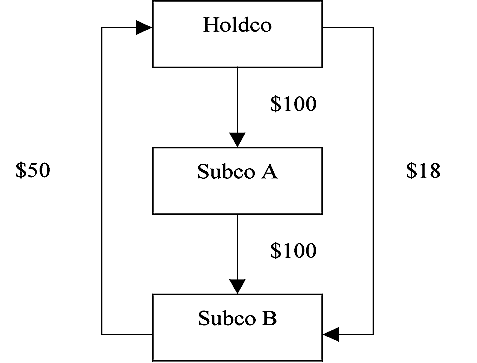
Holdco capitalises Subco A with $100 post-CGT. Subco A then capitalises Subco B with $100. Subco B subsequently makes a net capital loss (tax loss) of $50. Subco B transfers the loss to Holdco in return for a subvention payment of $18. The loss that Subco B made reduces the value of the shares held by Holdco in Subco A, and the shares held by Subco A in Subco B, by $50.
The cost base and reduced cost base of the shares held by Subco A in Subco B would be reduced by $32. This is calculated as the amount of the loss transferred ($50) less the amount of the subvention payment ($18). This reduction would prevent the loss of $50 being duplicated on the sale of the shares in Subco B. For the same reasons, the cost base and reduced cost base of the shares held by Holdco in Subco A would also be reduced by $32.

Holdco capitalises Subco A with $100 post-CGT. Subco A then capitalises Subco B with $100. Holdco subsequently makes a net capital loss (tax loss) of $50. Holdco transfers the loss to Subco B in return for a subvention payment of $18.
There would be no increasing adjustment to the cost base and reduced cost base of the shares held by Subco A in Subco B. This is because there has been no change to the market value of the shares owned by Subco A, since the commercial value of the loss transferred is equal to the subvention payment made for the loss. For the same reasons, there would be no adjustment to the cost base and reduced cost base of the shares held by Holdco in Subco A.
Application and transitional provisions
6. 55 The provisions will apply where losses are transferred under written agreements made on or after 22February 1999. In addition, for tax loss transfers, the provisions will only apply to CGT events happening in relation to shares or debts on or after 22 February 1999.
Consequential amendments
Income Tax Assessment Act 1997
6.56 Item 1 of Schedule 5 to this Bill repeals section 112-95 of the ITAA 1997 and inserts new section 112-95. Division 112 of the ITAA1997 contains modifications to the cost base and reduced cost base of a CGT asset. Section 112-95 contains a section finding table for modifications where there has been a transfer of a net capital loss within a wholly-owned group of companies.
6.57 However, Schedule 5 to this Bill introduces new Subdivision 170-C, which also deals with the transfer of a tax loss within a wholly-owned group of companies. Therefore, new section 112-95 contains a section finding table for modifications where there has been a transfer of a tax loss or a net capital loss. The section finding table refers to the provisions of new Subdivision 170-C.
6.58 Items 2 to 11 of Schedule 5 make consequential amendments to Subdivisions 170-A and 170-B of the ITAA 1997.
6.59 Items 2 and 3 insert notes into section 170-25 of Subdivision 170-A. Section 170-25 deals with the tax treatment of consideration paid for the transfer of a tax loss. The inserted notes provide that consideration paid for the transfer of a tax loss may affect how new sections 170-210 and 170-215 modify the cost base of direct and indirect interests in the loss company and income company.
6.60 Items 4 and 8 repeal subsections 170-105(4), 170-145(2), 170-145(3) and 170-145(4) of Subdivision 170-B. These provisions currently place a cap on the amount of net capital loss that can be transferred under Subdivision 170-B. The cap is equal to the unindexed amount of the cost bases of post-CGT equity and debt held directly by other companies in the wholly-owned group in the loss company.
6.61 The purpose of the cap was to prevent the loss company transferring an amount of net capital loss greater than the group had actually suffered, measured by reference to the amount of direct group investment in the loss company. The commercial debt forgiveness provisions now require compensating adjustments in most cases where a loss company is relieved of its obligations in respect of external debts so the overall aim of the cap is effectively achieved in another way. For this reason, and in light of the clarifications contained in this Bill for the cost base and reduced cost base regime for transferred net capital losses, the provisions implementing the cap will be repealed.
6.62 Item 5 inserts new subsection 170-105(8) into Subdivision 170-B. This provision will ensure that, in applying the provisions of Subdivision 170-B to net capital losses transferred under written agreements made before 22 February 1999, the net capital loss transfer provisions in new Subdivision 170-C are to be disregarded.
6.63 Items 6 and 7 amend the notes contained in section 170-125 of Subdivision 170-B. Section 170-125 deals with the tax treatment of consideration paid for the transfer of a net capital loss. The notes in the section currently make reference to section 170-175. However, as this section is being repealed (refer to item 10), the reference in the notes will be amended to refer to new section 170-220 and new section 170-225.
6.64 Items 9 and 11 are minor amendments to reflect that sections 170-175 and 170-180 of Subdivision 170-B will be repealed and a new Subdivision 170-B introduced.
6.65 Item 10 repeals sections 170-175 and 170-180 of Subdivision 170-B. These provisions currently deal with cost base adjustments where a net capital loss is transferred within a wholly-owned company group. As the cost base adjustments are now dealt with in new Subdivision 170-C, these provisions will be repealed. However, cost base and reduced cost base adjustments required by these provisions in respect of net capital losses transferred before the commencement of new Subdivision 170-C must still be made.
6.66 Items 13 and 14 of Schedule 5 make consequential amendments to the IT(TP) Act 1997.
6.67 Item 13 of Schedule 5 repeals sections 170-175 and 170-180 of the IT(TP)Act 1997. This reflects the amendments made by item 10. Item 14 amends the IT (TP) Act 1997 by reintroducing the sections repealed in item 13 as new section 170-220 and 170-225. This reflects the introduction of new Subdivision 170-C.
Income Tax Assessment Act 1936
6.68 Item 15 of Schedule 5 inserts new subsection 160ZP(16) into the ITAA 1936. This provision has the same operation as the provision introduced by item 5 (discussed at paragraph 6.62) except that item 15 deals with the net capital loss transfer provisions contained in the ITAA1936.
Financial Corporations (Transfer of Assets and Liabilities) Act 1993
6.69 The object of the FCA 1993 is to facilitate the transfer of assets and liabilities from certain subsidiaries of a particular foreign corporation to that foreign corporation or other subsidiaries, in certain circumstances.
6.70 Items 16 to 19 of Schedule 5 introduce consequential amendments to the FCA 1993. These amendments generally reflect other amendments introduced by Schedule 5.
6.71 Item 16 ensures that the tax loss transfer provisions contained in the FCA 1993 are the same as those contained in the ITAA 1997. Items 17 and 18 replicate the amendments made by items 6 and 7 of Schedule 5 (discussed at paragraphs 6.63). Item 19 replicates the amendment made by item 8 of Schedule 5 (discussed at paragraph 6.60).
